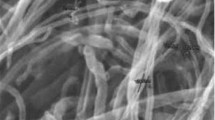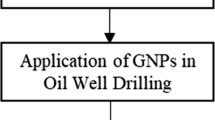Abstract
Carbon tubes, due to their unsurpassed aspect ratio, are a unique nanomaterial. The effect of carbon nanotube additions on the rheology of nanosuspensions is much more significant compared to spherical nanoparticles. This makes their use for improving drilling fluids very attractive. The work shows that with the help of nanoparticle additives it is possible to control the functional properties of drilling fluids over a very wide range. The article presents the findings of comprehensive experimental studies on the effect of multi-walled carbon nanotubes (MWCNTs) as additives, on the main functional characteristics of mineral oil-based emulsions used as drilling fluids (DF). Such systematic studies on oil-based DFs have been carried out for the first time. Nanotubes have been used to modify the formulations of typical DFs containing 65% of hydrocarbon phase. The weight concentration of nanotubes in emulsions was varied from 0.1 to 0.5%. The composition formula and preparation technique of stable DFs with CNT additives have been developed. The rheology, filtration and antifriction properties, temperature, and colloidal stability of oil-based DFs, modified by carbon nanotubes, have been studied. In general, the study has shown that adding MWCNTs even at low concentrations are capable of modulating significantly the characteristics of drilling oil-based emulsions. The addition of MWCNTs allows increasing the effective viscosity by 1.5 times and enhances the yield point of DFs, decreasing filtration loss by four times, and friction coefficient, by 20%, as well as increasing the stability of the emulsion by 2.7 times. The findings of this study can help for better understanding that the addition of MWCNTs to control the properties of hydrocarbon drilling fluids is a very promising direction in the development of drilling technologies in difficult mining and geological conditions.
Graphical abstract


















Similar content being viewed by others
Explore related subjects
Discover the latest articles, news and stories from top researchers in related subjects.Abbreviations
- K :
-
Measure of consistency (Pa·sn)
- n :
-
Degree of nonlinearity
- μ:
-
Effective viscosity, Pa·s
- τ0 :
-
Limit stress, Pa
- \({\dot{\gamma }}\) :
-
Shear rate, s−1
- API:
-
American Petroleum Institute
- CNT:
-
Carbon nanotube
- DF:
-
Drilling fluids
- FI:
-
Fluidity index
- HTHP:
-
High temperature—high pressures
- LTLP:
-
Low temperature—low pressures
- MSD:
-
Mean square displacement
- MWCNT:
-
Multi-walled carbon nanotube
- SLB:
-
Solid/liquid balance
- SSS:
-
Static shear stress
- TSI:
-
Turbiscan stability index
References
Apaleke AS, Al-Majed A, Hossain ME (2012) Drilling fluid: state of the art and future trend. NATC:SPE-149555-MS. https://doi.org/10.2118/149555-MS
Jiang G, Dong T, Cui K, He Y, Quan X, Yang L, Fu Y (2022) Research status and development directions of intelligent drilling fluid technologies. Pet Explor Dev 49:660–670. https://doi.org/10.1016/S1876-3804(22)60055-7
Siddig O, Mahmoud AA, Elkatatny S (2022) A review of the various treatments of oil-based drilling fluids filter cakes. J Pet Explor Prod Technol 12:365–381. https://doi.org/10.1007/s13202-021-01427-4
Li J, Yang P, Guan J, Sun Y, Kuang X, Chen S (2014) A new type of whole oil-based drilling fluid. Petrol Explor Dev 41:538–544. https://doi.org/10.1016/S1876-3804(14)60064-1
Zhuang G, Zhang Z, Jaber M (2019) Organoclays used as colloidal and rheological additives in oil-based drilling fluids: an overview. Appl Clay Sci 177:63–81. https://doi.org/10.1016/j.clay.2019.05.006
Mikhienkova EI, Lysakov SV, Neverov AL, Zhigarev VA, Minakov AV (2022) Experimental study on the influence of nanoparticles on oil-based drilling fluid properties. J Pet Sci Eng 208:109452. https://doi.org/10.1016/j.petrol.2021.109452
Minakov AV, Pryazhnikov MI, Suleymana YN, Meshkova VD, Guzei DV (2021) Experimental study of nanoparticle size and material effect on the oil wettability characteristics of various rock types. J Mol Liq 327:114906. https://doi.org/10.1016/j.molliq.2020.114906
Minakov AV, Mikhienkova EI, Zhigarev VA, Neverov AL, Rudyak VY (2018) A study of the influence of nanoparticles on the properties of drilling fluids. Colloid J 80:418–426. https://doi.org/10.1134/S1061933X18040099
Cheraghian G (2021) Nanoparticles in drilling fluid: a review of the state-of-the-art. J Mater Res Technol 13:737–753. https://doi.org/10.1016/j.jmrt.2021.04.089
Al-Shargabi M, Davoodi S, Wood DA, Al-Musai A, Rukavishnikov V, Minaev K (2022) Nanoparticle applications as beneficial oil and gas drilling fluid additives: a review. J Mol Liq 352:118725. https://doi.org/10.1016/j.molliq.2022.118725
Adil A, Baig T, Jamil F, Farhan M, Shehryar M, Ali H, Khushnood S (2023) Nanoparticle-based cutting fluids in drilling: a recent review. Int J Adv Manuf Technol. https://doi.org/10.1007/s00170-023-11048-2
Ismail AR, Aftab A, Ibupoto ZH, Zolkifile N (2016) The novel approach for the enhancement of rheological properties of water-based drilling fluids by using multi-walled carbon nanotube, nanosilica and glass beads. J Pet Sci Eng 139:264–275. https://doi.org/10.1016/j.petrol.2016.01.036
Chai YH, Yusup S, Chok VS, Arpin MT, Irawan S (2016) Investigation of thermal conductivity of multi walled carbon nanotube dispersed in hydrogenated oil based drilling fluids. Appl Therm Eng 107:1019–1025. https://doi.org/10.1016/j.applthermal
Sedaghatzadeh M, Khodadadi AA, Tahmasebi Birgani MR (2012) An improvement in thermal and rheological properties of water-based drilling fluids using multiwall carbon nanotube (MWCNT). IJOGST 1:55–65. https://doi.org/10.22050/ijogst.2012.2775
Akhilesh M, Santarao K, Babu MVS (2018) Thermal conductivity of CNT-watered nanofluids: a review. Mech Mech Eng 22:207. https://doi.org/10.2478/mme-2018-0019
Tawfik MM (2017) Experimental studies of nanofluid thermal conductivity enhancement and applications: a review. Renew Sust Energ Rev 75:1239. https://doi.org/10.1016/j.rser.2016.11.111
Fazelabdolabadi B, Khodadadi AA, Sedaghatzadeh M (2015) Thermal and rheological properties improvement of drilling fluids using functionalized carbon nanotubes. Appl Nanosci 5:651–659. https://doi.org/10.1007/s13204-014-0359-5
Abduo MI, Dahab AS, Abuseda H, AbdulAziz AM, Elhossieny MS (2016) Comparative study of using water-based mud containing multiwall carbon nanotubes versus oil-based mud in HPHT fields. Egypt J Pet 25:459–464. https://doi.org/10.1016/j.ejpe.2015.10.008
Kazemi-Beydokhti A, Hajiabadi AH (2018) Rheological investigation of smart polymer/carbon nanotube complex on properties of water-based drilling fluids. Colloids Surf A Physicochem Eng Asp 556:23–29. https://doi.org/10.1016/j.colsurfa.2018.07.058
Ozkan A (2020) Effect of gold nanoparticle functionalized multi-walled carbon nanotubes on the properties of na-bentonite water based drilling fluid. Fresenius Environ Bull 29:143–151. https://doi.org/10.18586/msufbd.489389
Anoop K, Sadr R, Yrac R, Amani M (2019) Rheology of a colloidal suspension of carbon nanotube particles in a water-based drilling fluid. Powder Technol 342:585–593. https://doi.org/10.1016/j.powtec.2018.10.016
Amin KB, Seyed HH, Ali S (2018) Surface modification of carbon nanotubes as a key factor on rheological characteristics of water-based drilling muds. IJCCE 37:1–14. https://doi.org/10.30492/IJCCE.2018.28219
Minakov AV, Mikhienkova EI, Zhigarev VA, Neverov AL (2018) An experimental study of the influence of added nanoparticles on the filtration of microsuspensions via porous media. Tech Phys Lett 44:532–534. https://doi.org/10.1134/S1063785018060251
Minakov AV, Mikhienkova EI, Voronenkova YO, Neverov AL, Zeer GM, Zharkov SM (2019) Systematic experimental investigation of filtration losses of drilling fluids containing silicon oxide nanoparticles. J Nat Gas Sci Eng 71:102984. https://doi.org/10.1016/j.jngse.2019.102984
Minakov AV, Mikhienkova EI, Matveev AV, Neverov AL (2019) Experimental study of antifriction properties of fluids with nanoparticles. J Frict Wear 40:420–424. https://doi.org/10.3103/S106836661905009X
Contreras O, Hareland G, Husein M, Nygaard R, Alsaba M (2014) Wellbore strengthening in sandstones by means of nanoparticle-based drilling fluids. In: SPE deepwater drilling and completions conference:SPE-170263-MS. https://doi.org/10.2118/170263-MS
Belousov PE, Krupskaya VV, Zakusin SV, Zhigarev VV (2017) Bentonite clays from 10th Khutor deposite: features of genesis, composition and adsorption properties. RUDN J Eng Res 18:135–143. https://doi.org/10.22363/2312-8143-2017-18-1-135-143
Acknowledgement
The research has been funded by the Russian Science Foundation Grant No. 23–79-30022, https://rscf.ru/project/23-79-30022/.
Author information
Authors and Affiliations
Corresponding author
Additional information
Handling Editor: Annela M. Seddon.
Publisher's Note
Springer Nature remains neutral with regard to jurisdictional claims in published maps and institutional affiliations.
Rights and permissions
About this article
Cite this article
Lysakova, E.I., Skorobogatova, A.D., Neverov, A.L. et al. A comprehensive study of the effect of multi-walled carbon nanotubes as an additive on the properties of oil-based drilling fluids. J Mater Sci 59, 4513–4532 (2024). https://doi.org/10.1007/s10853-024-09492-w
Received:
Accepted:
Published:
Issue Date:
DOI: https://doi.org/10.1007/s10853-024-09492-w




